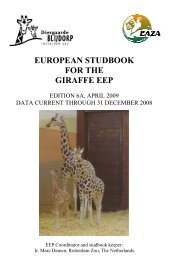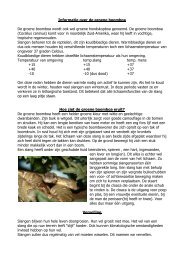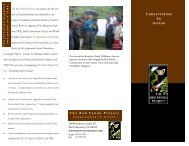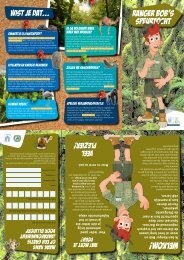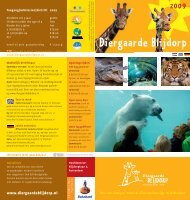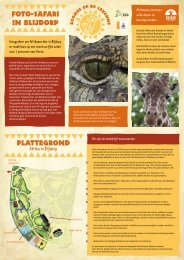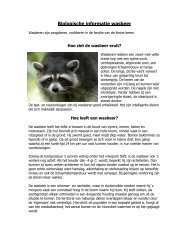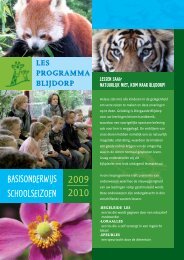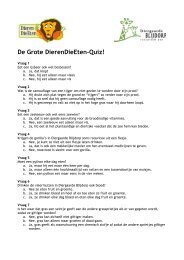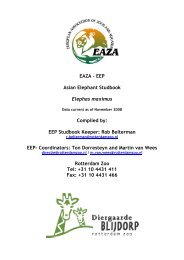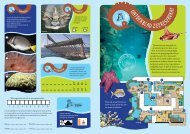Create successful ePaper yourself
Turn your PDF publications into a flip-book with our unique Google optimized e-Paper software.
<strong>EEP</strong> STUDBOOK CROWNED PIGEONS<br />
The Kurija currently live in two villages, Totai and Mirimas, along Biaru River just south of<br />
Kakoro. They make their gardens in the floodplain of the river and along several of its smaller<br />
tributaries. The Kurija are concerned about large-scale development or resource extraction<br />
projects. They are opposed to large mining projects because of the chemicals ("marasin" in<br />
tok pisin) that are released into local waterways, which can poison the fish and other riverine<br />
life, which makes it also impossible to drink the water from the rivers. Furthermore they are<br />
concerned that the noise from generators and engines would scare off the wildlife and ruïn<br />
their hunting. They also fear that the people brought from the outside to work on these<br />
projects might cause trouble and disrupt their way of live ("bagarapim ples" in tok pisin).<br />
They opposed having large corporations operate in the basin, although they were supportive<br />
of smaller-scale development projects that would not harm the natural environment ("spilim<br />
ples" in tok pisin).<br />
The Kamea living on the edge of the Lakekamu River have close ties to the communities in<br />
the Kaintiba and Kamena regions of the Gulf Province. Tekadu and Nukeva are the Kamea<br />
villages located closest to the basin. Their exchange relations were oriented towards other<br />
Kamea communities living at higher altitudes, to which they traded lowland products. As a<br />
consequence, the Kamea had no pre-contact social relations with their neighbours in the<br />
Lakekamu Basin.<br />
The Kamea village of Iruki was established by the residents of Nukeva and Tekadu after<br />
Kakoro was founded in 1972. After primary schools were built in the mountain villages, most<br />
of the Kamea living at Iruki returned home. To maintain their settlement at Iruki, and to<br />
protect their rights to nearby land and resources, the Kamea invited people from outside of the<br />
basin to settle in Iruki in their place. Most of the inhabitants of Iruki came from Kamena and<br />
Kaintiba in the mountains. Few of the people living in the village have local land rights,<br />
because they are "place-holders" for the residents of Nukeva and Tekadu. Although they have<br />
permission to exploit the resources of the basin themselves, they do not have the right to<br />
decide its fate with respect to development or conservation projects.<br />
The Kovio live in three villages (most of them in Okovai) at the western edge of the<br />
Lakekamu Basin, and in urban areas of Gulf and Central Province, including Kereman and<br />
Port Moresby. The Kovio claim that they have strong cultural communities with the<br />
neighboring Mekeo, including the ritual body and face-painting style that has made the<br />
Mekeo famous throughout Papua New Guinea. They <strong>number</strong> less than 500.<br />
The Kovio live in the flat, swampy lowlands along the southern tributaries of the Kunimaipa<br />
River until they moved north to the junction of the Kunimaipa and Biaru Rivers, probably in<br />
the 1950s. When this settlement was flooded, the Biaru moved further west to the land<br />
adjoining the Kunimaipa and Tiveri Rivers, the current location of Okovai village. Urulau<br />
village is west of Okovai, near the border between Central and Gulf Provinces, and Ungima is<br />
a new settlement closer to the Mekeo. Unlike their neighbours, they have no village in the<br />
immediate vicinity of Kakoro, although several Kovio are civil servants employed at the<br />
government.<br />
The Kovio claim ownership of most of the land in the Lakekamu Basin. Given the friction<br />
between the Kovio and the Kamea in pre-colonial times, it is not surprising that the boundary<br />
between them remains in dispute. The Kovio were strategically located along a major<br />
waterway between the coast and the mountains and they acted as intermediaries through<br />
whom the products of the sea and the mountains passed both ways.<br />
130



